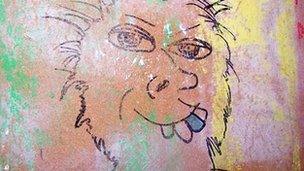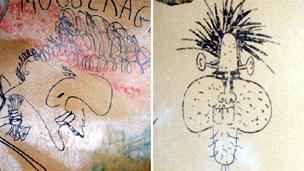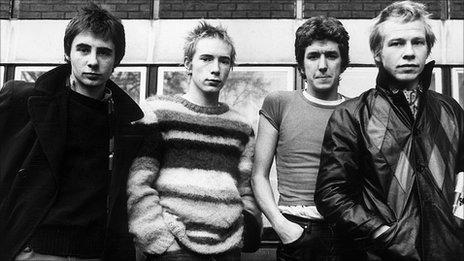Johnny Rotten graffiti is 'important' say academics
- Published
Could the Sex Pistols' graffiti hold more significance than early Beatles recordings?
Graffiti by Sex Pistols frontman Johnny Rotten may be of greater significance than the discovery of early Beatles recordings, academics have said.
Rotten, born John Lydon, drew on the walls of the band's London flat in 1975 after disliking a recent redecoration.
Now, a paper in the journal Antiquity is suggesting the flat is an important historical and archaeological site.
The authors say it is "a direct and powerful representation of a radical and dramatic movement of rebellion."

In one of the drawings, the singer drew himself with a rotten tooth
The graffiti mainly consists of eight cartoons drawn in black marker pen in the upper room of the flat on Denmark Street, which is now used as shop offices.
'Unique insight'
They depict Lydon himself and other members of the band including Sid Vicious and their manager, the late Malcolm McLaren.
Co-authors Dr John Schofield and Dr Paul Graves-Brown say: "The tabloid press once claimed that early Beatles recordings discovered at the BBC were the most important archaeological find since Tutankhamun's tomb.
"The Sex Pistols' graffiti in Denmark Street surely ranks alongside this and - to our minds - usurps it.
"The fact that the graffiti could be considered rude, offensive and uncomfortable merely enhances their status and significance."
The researchers question why graffiti from 1975 should not be approached, in an archaeological sense, with the same seriousness as drawings on walls from thousands of years earlier.
"As authors we remember 1975 but surely that is the only difference," they say.

Rotten also drew cartoons of the band's manager Malcolm McLaren and bandmate Sid Vicious
"Deconstruction of the graffiti...presents a layering of time and changing relations. Whilst some of this is documented in published biographies, this very archaeological record offers something visceral and immediate and generates unique insight.
"This is an important site, historically and archaeologically, for the material and evidence it contains."
The current occupants of the house have said they have no future plans to remove the graffiti.
- Published22 July 2011

- Published21 April 2011

- Published22 November 2010